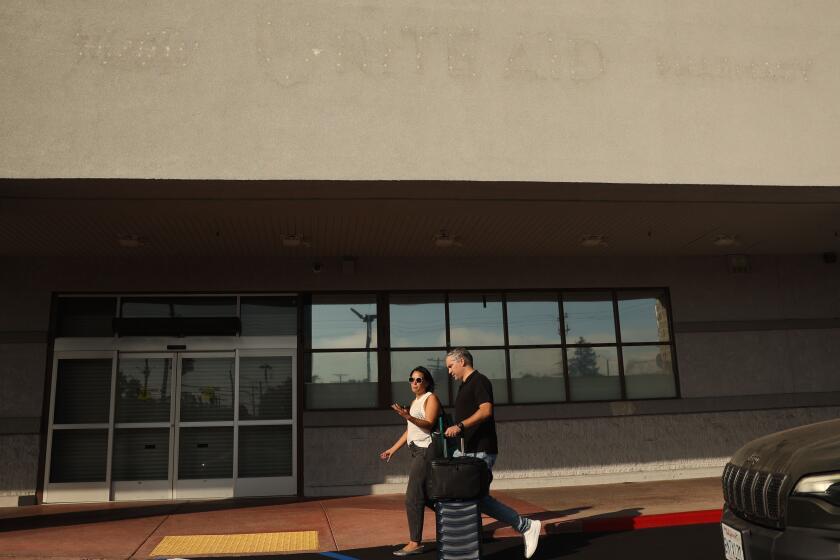Cause of Fatal Rockwell Blast Under Scrutiny
Federal agents are investigating whether two Rockwell International Corp. scientists killed in an explosion last year were actually blowing up toxic waste rather than conducting valid rocket fuel tests, government officials said Friday.
Burning off unneeded rocket fuel chemicals would violate federal environmental laws and breach cleanup contracts that paid Rockwell more than $1 million, the officials said.
“They were supposed to dispose of it in accordance with environmental regulations,” one federal investigator said. “By going out in the back yard and disposing of it, you are polluting the environment and causing harm to the government.”
Otto K. Heiney and Larry A. Pugh were killed and a third worker was hurt July 26, 1994, when the nitrocellulose and glycidal azide polymer they were handling blew up in their faces at the Rocketdyne division’s test lab near Simi Valley.
After the blast, Rockwell officials said the scientists had set up acoustic probes near the open-air test stand in Happy Valley. The rock-lined bowl is at the 2,700-acre Santa Susana Field Laboratory where the firm’s Rocketdyne division develops rocket engines.
The probes, Rocketdyne President Paul Smith has said, were used to record shock waves from what were supposed to be controlled explosions while the scientists waited in a safe bunker.
Rocketdyne spokesman Paul Sewell refused to comment Friday on the investigation or whether the scientists had died while trying to get rid of the rocket fuel.
“It would be impossible to speculate,” he said.
Nor would he confirm whether Rocketdyne had contracts to dispose of the rocket fuel ingredients. Typically under federal contracts, Rockwell would be reimbursed for the cost of disposing of hazardous or toxic material by whatever agency issued the contract that generated the waste.
On Thursday, about 40 agents from the FBI, Environmental Protection Agency, National Aeronautics and Space Administration and the Departments of Defense, Energy, Air Force and Navy raided Rocketdyne’s field lab and Canoga Park headquarters, seizing files relating to the explosion.
Over the years, NASA, the Energy Department and the military agencies have all contracted with Rocketdyne for various research projects at the rugged Santa Susana Field Lab, ranging from nuclear reactor testing to development of space shuttle engines.
“There is a loss to all the agencies if the propellant isn’t disposed of properly,” said an investigator close to the case. The government could then be liable for the pollution, he said.
Officials said they did not know whether burning off the toxic chemicals would create any health risk for nearby communities.
Immediately after the fatal blast, the California Division of Occupational Safety and Health Administration and Rocketdyne engineers launched investigations.
In January, Cal/OSHA levied $202,500 in fines against Rockwell International for four serious violations of worker safety rules that may have contributed to the blast.
Also, investigators found that Rocketdyne violated state regulations by failing to tell Cal/OSHA where and when the explosives were being made.
Rocketdyne is appealing the citations, said Sewell, the company spokesman.
On the day of the accident, Rocketdyne’s investigators concluded that static, a spark or a hot pan from an earlier test ignited about two pounds of highly volatile nitrocellulose in the half-full, open plastic container that one worker was carrying.
Heiney, 53, a Canoga Park engineer and Pugh, 51, a Thousand Oaks physicist, died instantly, while test mechanic Lee Wells, 62, of Newbury Park, suffered second- and third-degree burns.
Heiney’s widow, Judith Heiney, reached at her home in Shalimar, Fla., said Friday that her attorney has warned her not to comment on the case.
Pugh’s family could not be reached for comment.
Wells, who has since returned to work at Rocketdyne, did not return calls from The Times.
Times staff writer Ralph Vartabedian contributed to this report.
More to Read
Inside the business of entertainment
The Wide Shot brings you news, analysis and insights on everything from streaming wars to production — and what it all means for the future.
You may occasionally receive promotional content from the Los Angeles Times.










